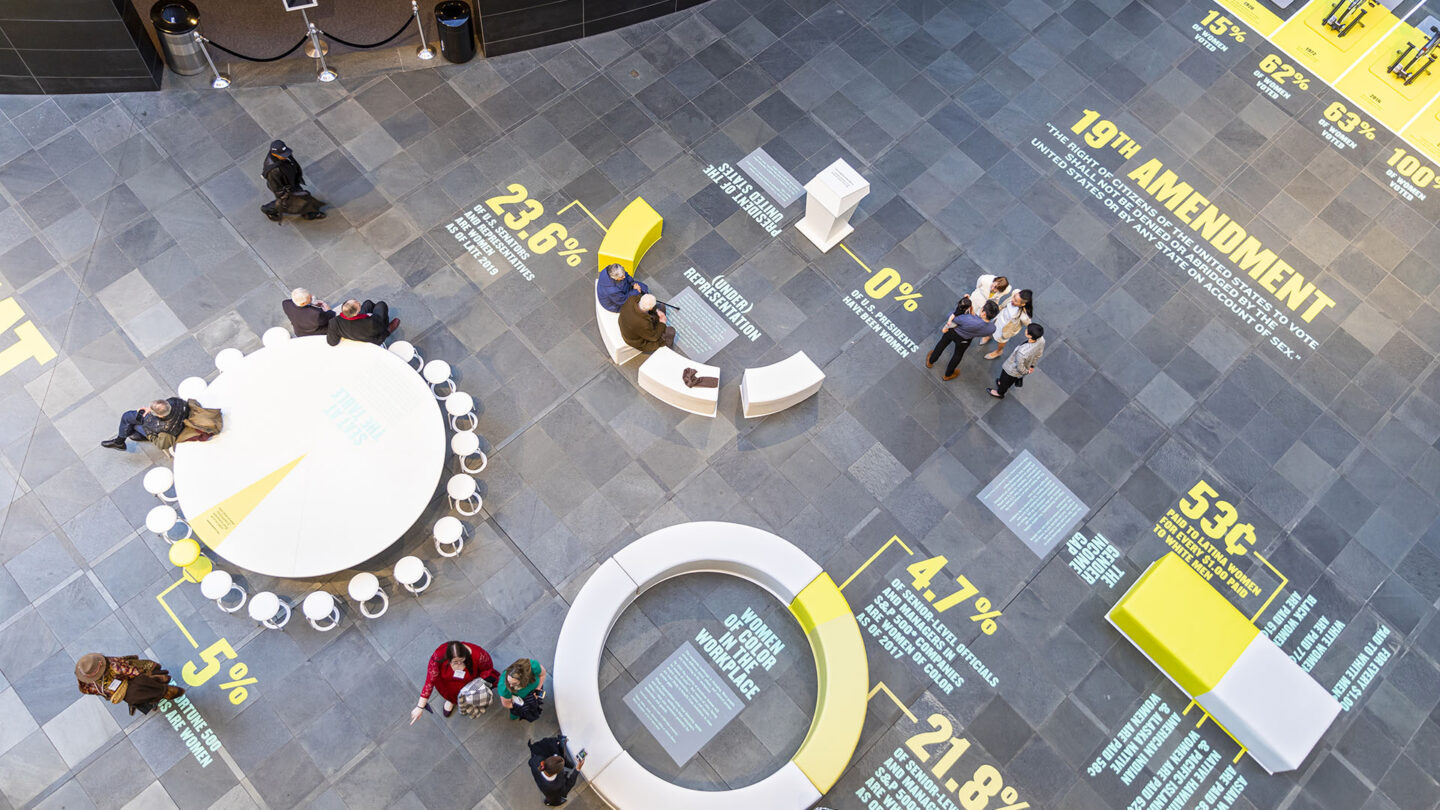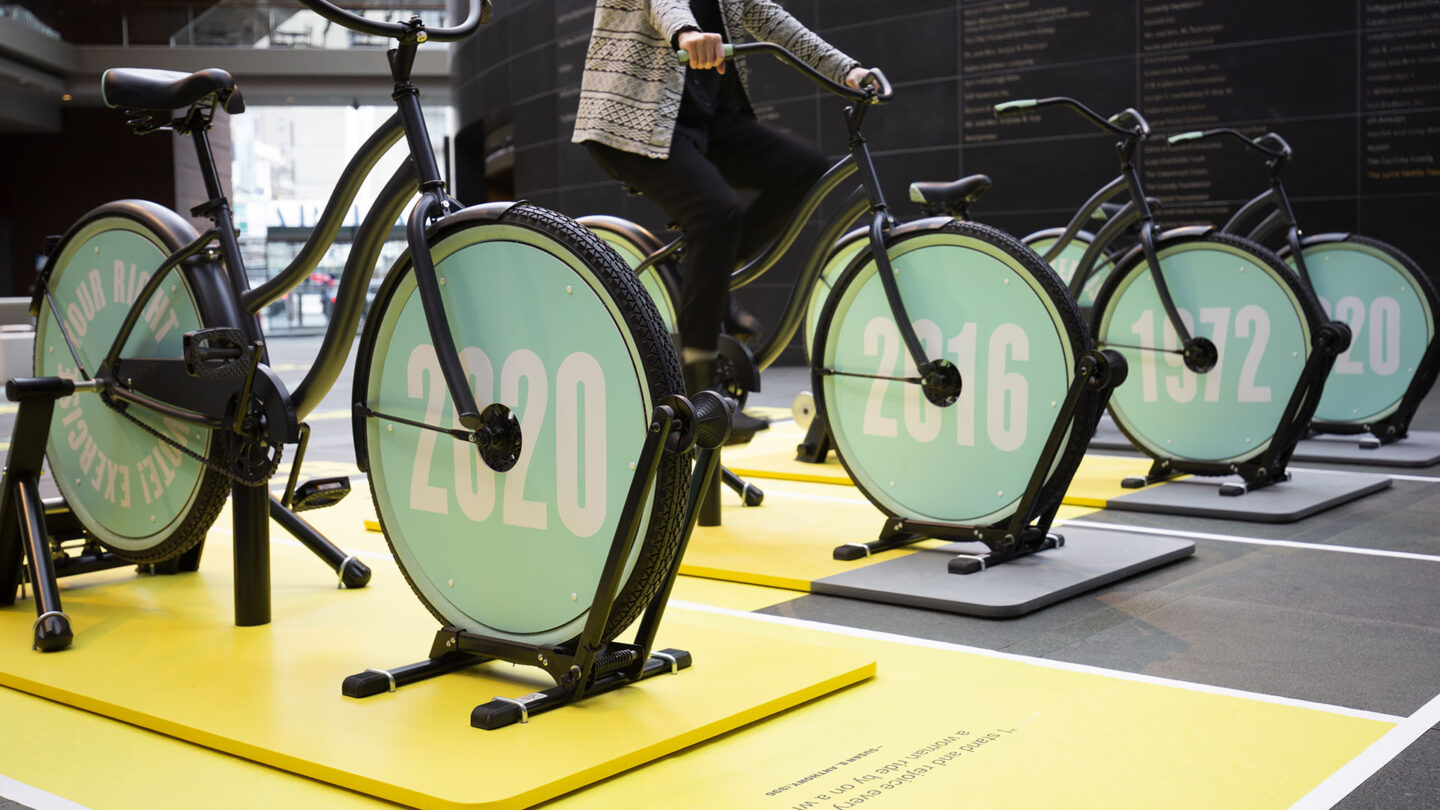Seat at the Table
Highlighting the current state of gender inequity in America on the centennial of the 19th Amendment to the U.S. Constitution, this exhibition asks, “Where are we now?” Challenged to capture the attention of visitors without leaning on partisan cues, the experience centers around having a “seat at the table” to connect history with relevant and necessary action.
Agency
Dome Collective
Practice Area
Client
Drexel University, Institute for Women’s Health & Leadership, Vision 2020
Industry

The Challenge
The American suffrage movement being marked by racial discrimination as it prioritized the vote for white women added to a long history of one marginalized group “winning” at the expense of others. A key strategy for the Institute for Women’s Health and Leadership is building diverse coalitions, so the challenge was to inspire all audiences to be advocates for gender equity.
Project Vision
Dome created an experience around having a “seat at the table.” The form of the seat and its symbolism create multiple points of entry for visitors of different ages, genders, and abilities. Inspired by the Kimmel Center’s surrounding theaters, the exhibition acts as an open stage, inviting visitors to become participants in each scene.

The Kimmel Center for the Performing Arts hosts the 6,000-square-foot exhibition in its public atrium.
Visitors can view the entire installation from multiple balconies above.
Jens Ohlsson, Dome Collective

Seven areas represent the state of women today in leadership, workforce, and voter participation. Viewers experience a grand, telegraphic view from above and a close, interactive experience on the ground.
Jens Ohlsson, Dome Collective

Yellow and white, key colors of women’s suffrage, demarcate the disparity between women and men. 1 of 20 chairs represents the 5% slice of Fortune 500 CEOs who are women.
Jens Ohlsson, Dome Collective

Vinyl floor graphics provide context to a dollar-shaped chaise which shows the gender income gap delineated by ethnicity.
Jens Ohlsson, Dome Collective
Design + Execution
While the exhibition honors women’s suffrage and its pioneers, the purpose was to address the current, deep imbalance of decision makers in our country and engage multiple generations across the political spectrum towards civic engagement. Dome worked closely with the Vision 2020 team to create a strategic plan for the visitor experience and the physical components that would bring stories of empowerment, disenfranchisement and intersectionality to life.
The custom- built furniture, color palette, and scale of typography takes advantage of the expansive space and elevated vantage points. As visitors move through the atrium, they encounter a series of statistics as though stepping into an analysis of the country—pie charts and bar graphs are extruded into furniture, numbers are two feet long and titles can be read from three balconies above.
At the ground level, visitors can walk through the exhibition reading content at a grand scale. They can also dwell longer on each piece for a more intimate experience that is accessible to visitors of various ages, heights and abilities. From a bird’s- eye view, visitors can see how elements of the exhibit align to the slate floor tiles like a sheet of grid paper.
All physical components, including the interactive screens, are modular and movable. In addition, the visitor journey takes advantage of the asymmetrical angles in the space and inclined floor with site- specific environmental graphics.

The invention of the bicycle advanced women’s mobility and symbolizes the past 100 years of voter turnout in the exhibit.
Jens Ohlsson, Dome Collective

18 cafe tables show the proportion of women in occupations across different sectors including finance, education, government, military, healthcare, STEM, and media.
Jens Ohlsson, Dome Collective

Six interactive screens feature dynamic quotes, portraits, and contributions of eighteen pioneering women since 1920. “What’s Your Vision?” polls visitors on issues that best advance gender equality in 2020.
Jens Ohlsson, Dome Collective
Project Details
When I think of design excellence, I think of design that pushes forward a conversation. This project was refreshing, elegantly executed and served the purpose of facilitating important conversation.
Ingenious use of vertical and lateral space to present 3D infographics about gender inequality 100 years after women got the right to vote in the US. A simple, elegant design solution that powerfully calls attention to a persistent social inequity. This exhibit deftly harnesses the environmental characteristics of a public space to communicate on multiple levels: from balconies above, and on the exhibit floor itself—all with basic materials. Brilliant!
Simple, memorable and beautiful. This installation utilize the space of the atrium and the different view points beautifully. Inviting visitors to participate by taking a seat themselves is a smart way of humanizing the statics (especially considering the added psychological effect that most people would sit on the white „majority“ seats and would not want to be singled out by sitting on the yellow ones highlighting the message anew).
This project really transforms this space into an information landscape that you can inhabit. When I first looked at the images, I assumed that they were digital infographics. It was upon closer inspection that I could see the meticulous details that make this data readable from many different perspectives. The fact that real people walk around and inhabit those graphics (even unknowingly), reiterates that this data represents real experiences, and reflects trends that are bigger than any one person. It is a strong execution with an important message that I think is memorable and meaningful.
Design Team
Katie Lee
Lynn Kiang (exhibition strategy, creative direction, design lead)
Collaborators
Art Guild, Inc. (fabricator)
Lynn H. Yeakel (Director, Institute for Women’s Health & Leadership; Founder and President, Vision 2020)
Melissa Clemmer, Lenfest Center for Cultural Partnerships, Drexel University (curator/project manager)
Page Talbott, Lenfest Center for Cultural Partnerships, Drexel University (curator/project manager)
Joanne Murray (Vision 2020 Historian)
Dan Basmajian, MakerB Studio (soft furnishings design)
This is our work (graphic design)
Bad Idea Factory (software development)
Photo Credits
Jens Ohlsson, Dome Collective (photography)
Les Munoz (videography)
Dome Collective (video editor)
Open Date
March 2020




